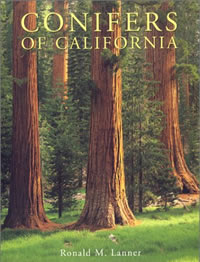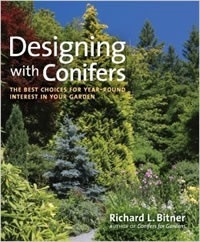 Conifers of California is a delightful introduction to many of our native conifers, as well as the incredible diversity of these cone bearing trees to be found further down the coast. Author Ronald M. Lanner writes what could be best described as a biography of each tree, telling the natural history and the interaction of each with humans and animals. While there are helpful descriptions, (including “At a distance”, “Standing beneath it”, and “In the hand”), this is not primarily a field guide.
Conifers of California is a delightful introduction to many of our native conifers, as well as the incredible diversity of these cone bearing trees to be found further down the coast. Author Ronald M. Lanner writes what could be best described as a biography of each tree, telling the natural history and the interaction of each with humans and animals. While there are helpful descriptions, (including “At a distance”, “Standing beneath it”, and “In the hand”), this is not primarily a field guide.
The photographs are excellent, but a bigger visual draw are the botanical paintings by Eugene Otto Walter Murman (1874-1962), which besides being beautiful, clearly show the distinctiveness of the cones, cone scales, seeds, needles in a single bundle, and a growing tip. Adding to the history are quotes by some of the great describers of trees, including Charles Sprague Sargent, John Muir, and, one of my favorites, Donald Culross Peattie.
I’m adding Lanner to this list. His descriptions of the relationship between the Clark’s nutcracker and whitebark pine (Pinus albicaulis), or the unusual combinations of factors that lead to the long, long lives of the bristlecone pine (Pinus longaeva), are detailed and lengthy but totally engaging.
Of incense-cedar (Calocedrus decurrens) he explains how forestry practices have led to a population explosion of this tree little valued by the timber industry. This is “…good for those Americans who eschew the use of greasy-inked ballpoint pens, because incense-cedar is the unrivaled champion of available domestic pencilwoods. It may not be so good for those…who must past through thickets…for those thin dead, lower limbs seem always positioned to welt a cheek or poke an unsuspecting eye.”
Many of the rarer California conifers can be found in the Arboretum and this book is a good introduction. Look for the Coulter pine (Pinus coulteri) but don’t stand under its eight pound cones
“with talonlike appendages”, while from the Siskiyou Mountains comes the weeping Brewer spruce (Picea breweriana) with “long, dark-foliaged, pendulous branches.”
 Richard Bitner has written three books about conifers in the garden; I think the best is the most recent,
Richard Bitner has written three books about conifers in the garden; I think the best is the most recent,  Conifers of California is a delightful introduction to many of our native conifers, as well as the incredible diversity of these cone bearing trees to be found further down the coast. Author Ronald M. Lanner writes what could be best described as a biography of each tree, telling the natural history and the interaction of each with humans and animals. While there are helpful descriptions, (including “At a distance”, “Standing beneath it”, and “In the hand”), this is not primarily a field guide.
Conifers of California is a delightful introduction to many of our native conifers, as well as the incredible diversity of these cone bearing trees to be found further down the coast. Author Ronald M. Lanner writes what could be best described as a biography of each tree, telling the natural history and the interaction of each with humans and animals. While there are helpful descriptions, (including “At a distance”, “Standing beneath it”, and “In the hand”), this is not primarily a field guide.